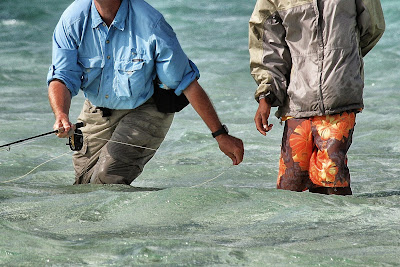The cast is a good one. Following his guide's instruction, the angler strips his line soon capturing the attention of the bonefish. The fish turns to follow the fly, then as the bone tips down, his broad tail breaks the surface. The angler holds his breath and listens intently for further instructions. Calmly his guide says "lonnnng strip"!
Have you ever wondered why experienced bonefish guides ask for that lonnnng strip... just at that moment when the bonefish tips down to eat?
Well, it's not because the guide wants that angler to move the fly again. Instead, the guide knows the fish has eaten the fly. He wants the angler to remain calm and yet strike the fish! The guide is using a somewhat devious method to make sure the angler does not raise his rod in an effort to set the hook. Why? Because, raising a rod's tip skyward on the hook set turns the rod into a shock absorber greatly diminishing the energy of the strike. As a result, the fly frequently fails to obtain a solid purchase and skips out. Raising the rod tip may protect the light tippet on a trout leader and be sufficient to force the thin wire of a trout fly into a trout's relatively soft mouth… but it's not enough for a bonefish, or most other ocean species for that matter.

So if you want to catch more bonefish, you must learn to properly strip strike. While the strip strike used for bonefish is a less violent strip strike than the more powerful method used on extremely hard mouthed and hard charging species like tarpon and GT's, the mechanics are the same. The bottom line is, if you learn to strip strike, you will hookup more often simply because YOU DIDN"T RAISE THE ROD TIP!
Here are the basics of a good strip strike for bonefish, redfish and other ocean fish with a relatively soft mouth:
Step 1: As you strip line to impart action to your fly, keep your rod tip low and pointed directly at the fish.
Step 2: When you see the fish tip down to eat or you feel your line come tight, continue to keep your rod pointed straight at the fish and give one quick, long strip. ( I like to drop my line hand sharply down straightening the elbow which allows your hand to move behind you. If you keep your elbow bent and only pull straight back on the line you get a much shorter strip with less power. Try it! )
Step 3: If the fish has eaten, your line hand may stop before it gets behind you (as the hook point comes home) OR the bonefish will turn and take off (be prepared to quickly let your line slip through your fingers!). Either way, you’re in good shape and the hook is set. Now you can raise your rod and use it for what it is when fighting a fish… a shock absorber.
It can be hard to train yourself not to raise your rod when striking (especially if you are a trout fishermen). But if you keep stripping with the rod tip pointed directly at the fish until the line comes tight (and you don’t raise your rod tip), you'll more often than not bury the hook in the bone's mouth and get a good hook set.
This is all you need to know to properly set a hook in a bonefish. But there is more to learn about the strip strike, especially if you want to fish for the extremely boney-mouthed and hard charging species like tarpon or GT's.
So with that in mind, here is a bit more on the strip strike:
As you are stripping the fly with your rod pointed directly at the fish etc. (see above) your rod hand should be out in front of you. This gives you, when the fish eats your fly, the full span of your arms for the strip set (i.e. your maximum strip set occurs when your rod hand is well out in front of you and your line hand is fully stretched out behind you).
If you reach that frustrating moment when you are still not tight to the fish, but your line hand is fully extended after completing a strip strike (this occurs most often as the fish is charging towards you), don't resort to a trout set to take up more line! Instead, clamp down on the line which is running under the index and middle fingers of your rod hand, and again, still keeping the rod pointed directly at the fish, pull strongly straight back with your rod hand as far as you can or until it comes tight (the power you choose to put in this move depends on the species you are fishing for).
These two strips (the one with your line hand arcing behind you and the subsequent one with your rod hand) can be done smoothly and sequentially. Putting these two strips together can take up one hell of a lot of line without the need to reposition you line hand (which can be a game-ending move!). You can also repeat these rod hand jabs quickly, one after the other, if you feel you didn't get a good hook set with the preceding one.
One other note, as you perform this rod hand strike, move your other hand (line hand) forward at the same time. This will put you in good shape to clear your line when the fish comes tight and also repositions you for another line hand strip if necessary. Done properly, these techniques create a powerful tool… good enough to put a hook point in any tough ocean species from permit to giant trevally to tarpon.
Learn the bonefish strip strike and instead of hearing "lonnnng strip" from you guide, you’ll hear “nicely done”.
Learn the rod hand strike and you'll be successful with any saltwater species!





